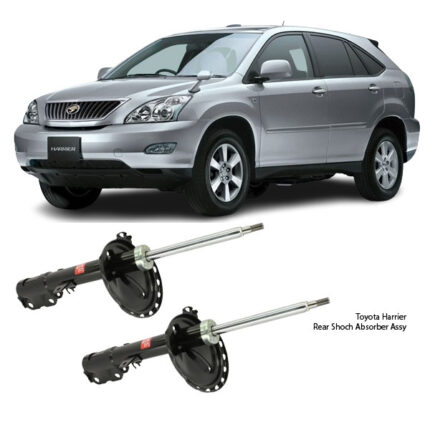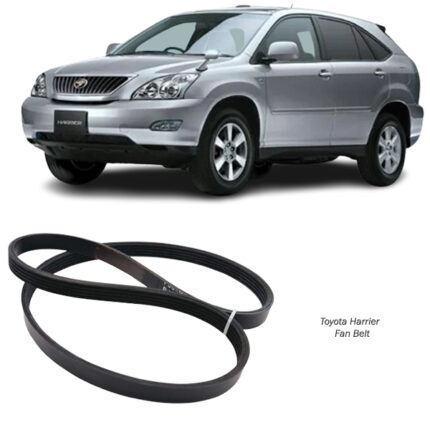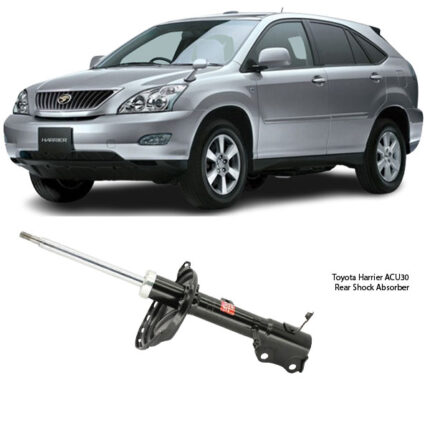Get Toyota Harrier ACU30/MCU30 4wd Rear Shock Absorber Assy 334394/95 in Kenya
A Rear Shock Absorber Assembly is a crucial part of a vehicle’s suspension system, ensuring smooth rides, improved handling, and enhanced safety. Whether you’re a car enthusiast 🏎️, a mechanic 🔧, or just a curious driver 🚗, this guide will break down everything you need to know about rear shock absorber assemblies.
1. What is a Rear Shock Absorber Assembly? 🤔
A rear shock absorber assembly is a system designed to dampen shocks and vibrations that occur when a vehicle moves over uneven surfaces. It absorbs kinetic energy from the road, preventing excessive bouncing and ensuring that the tires remain in contact with the ground.
Components of a Rear Shock Absorber Assembly 🔩:
- Shock Absorber (Damper) 🛠️ – Controls unwanted motion by converting kinetic energy into heat.
- Spring (Coil or Leaf) 🔄 – Supports the vehicle’s weight and absorbs large shocks.
- Mounting Bushings 🏗️ – Reduce noise and vibrations between the shock absorber and the vehicle body.
- Piston and Cylinder 🏺 – The piston moves within the cylinder, forcing oil or gas through valves to dissipate energy.
- Oil or Gas Chamber 🛢️ – Filled with hydraulic fluid or gas (nitrogen) for smooth damping.
2. How Does a Rear Shock Absorber Work? ⚙️
The shock absorber functions by controlling the rebound and compression of the suspension system. Here’s how:
-
Compression Stroke ⬇️:
- When the vehicle hits a bump, the piston inside the shock absorber moves downward.
- The hydraulic fluid is forced through small valves, controlling the rate of movement.
- The suspension compresses, absorbing the impact.
-
Rebound Stroke ⬆️:
- As the vehicle moves past the bump, the spring pushes back to its original position.
- The piston moves upwards, and the hydraulic fluid flows through different valves to slow the movement.
- The controlled rebound prevents excessive bouncing.
3. Types of Rear Shock Absorbers 🛞
There are different types of shock absorbers, each designed for specific performance needs:
1. Hydraulic Shock Absorbers (Oil-Filled) 🛢️
- Uses hydraulic oil to absorb shocks.
- Common in older and budget-friendly cars.
- Provides a smooth ride but may overheat during heavy use.
2. Gas-Filled Shock Absorbers (Gas-Charged) ⛽
- Filled with nitrogen gas to prevent oil foaming.
- Offers better handling and performance.
- Ideal for high-speed or off-road vehicles.
3. Coilover Shock Absorbers 🌀
- Combines a shock absorber with a coil spring.
- Used in performance cars and racing applications.
- Allows for adjustable ride height and damping settings.
4. Air Shock Absorbers 🌬️
- Uses air instead of oil for damping.
- Often found in luxury and off-road vehicles.
- Allows for ride height adjustments.
5. Adaptive & Electronic Shock Absorbers 📡
- Adjusts damping in real-time using sensors and electronic controls.
- Provides the best balance between comfort and handling.
- Found in modern high-end vehicles.
4. Signs of a Failing Rear Shock Absorber 🚨
A worn-out shock absorber can severely impact your driving experience. Look out for these signs:
🔹 Excessive Bouncing – The car bounces too much after hitting a bump.
🔹 Poor Handling – Steering feels loose or unstable.
🔹 Uneven Tire Wear – Tires show irregular wear patterns.
🔹 Leaking Fluid – Oil leaks from the shock absorber body.
🔹 Noisy Suspension – Clunking or knocking sounds when driving.
🔹 Longer Stopping Distance – Braking efficiency is reduced.
If you notice these symptoms, it’s time to replace or repair your rear shock absorber assembly! 🔧
5. Benefits of a Well-Maintained Rear Shock Absorber 🌟
✔️ Improved Comfort – Smooths out bumps and vibrations.
✔️ Better Handling – Enhances steering and stability.
✔️ Increased Safety – Reduces braking distance and prevents loss of control.
✔️ Longer Tire Life – Minimizes uneven wear and tear.
✔️ Less Strain on Other Components – Protects suspension parts from excessive stress.
6. How to Replace a Rear Shock Absorber 🔨
Replacing a rear shock absorber is a moderate-level DIY task or can be done by a professional mechanic. Here’s a basic step-by-step guide:
Tools Required 🛠️:
✅ Jack & Jack Stands
✅ Wrenches & Ratchet Set
✅ Torque Wrench
✅ New Shock Absorbers
Step-by-Step Process:
1️⃣ Lift the Vehicle – Secure the car with jack stands.
2️⃣ Remove the Old Shock Absorber – Unscrew the mounting bolts and take out the worn-out shock.
3️⃣ Install the New Shock Absorber – Align it properly and tighten the bolts to the correct torque.
4️⃣ Test the Suspension – Lower the car and check for smooth movement.
🚨 Tip: Always replace shocks in pairs (left & right) for balanced performance!
7. Maintenance Tips for Rear Shock Absorbers 🛑
🔧 Inspect Regularly – Check for leaks and wear every 10,000 miles.
🚗 Drive Carefully – Avoid potholes and rough terrains when possible.
🛢️ Lubricate Bushings – Keep the mounting points well-maintained.
🛠️ Replace When Needed – Most shocks last between 50,000-100,000 miles.
8. Choosing the Right Rear Shock Absorber for Your Vehicle 🚙
When buying a shock absorber, consider:
✔️ Vehicle Type – Different shocks for sedans, SUVs, trucks, and performance cars.
✔️ Driving Style – Daily driving, off-roading, or racing.
✔️ Budget – High-end brands offer better durability and performance.
✔️ OEM vs. Aftermarket – OEM for reliability, aftermarket for customization.
9. Popular Brands of Rear Shock Absorbers 🏆
🛠️ KYB – Reliable and widely used.
🛠️ Bilstein – High-performance shock absorbers.
🛠️ Monroe – Budget-friendly and durable.
🛠️ Fox Racing – Ideal for off-road and extreme use.
🛠️ Gabriel – Affordable with decent performance.
10. Conclusion 🎯
The Rear Shock Absorber Assembly plays a vital role in vehicle performance, comfort, and safety. Whether you’re replacing old shocks or upgrading for better performance, choosing the right type and maintaining them properly ensures a smooth and stable ride.
🚗 Drive Smooth, Stay Safe! 🏁
Follow us on Facebook for more parts.




